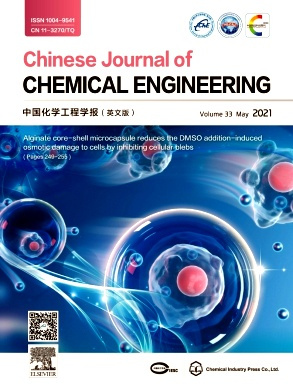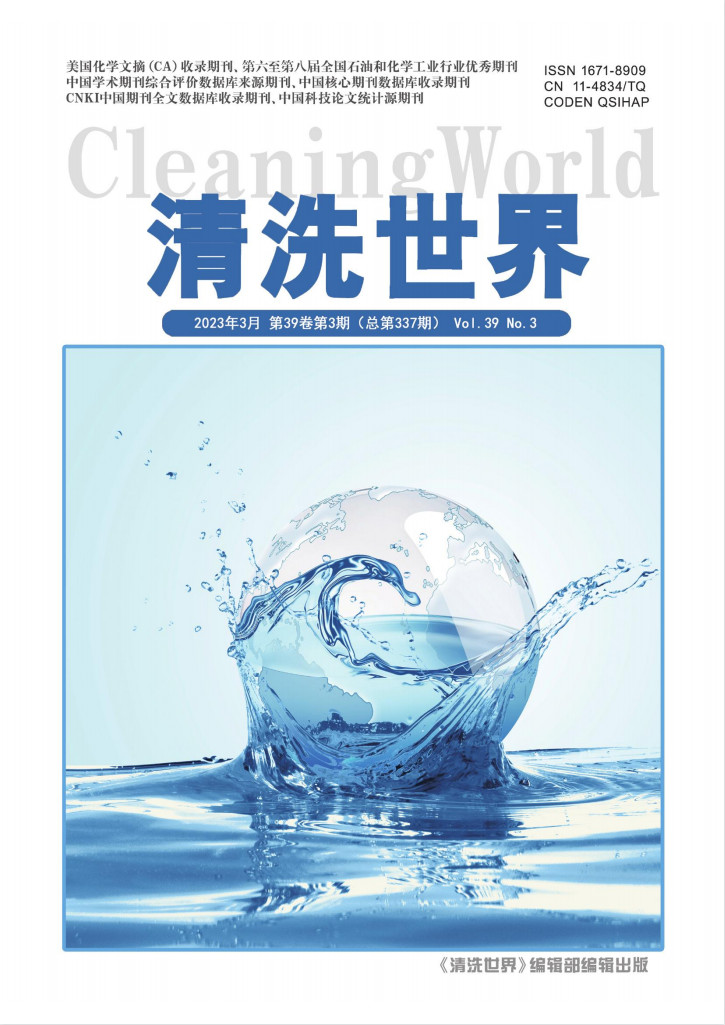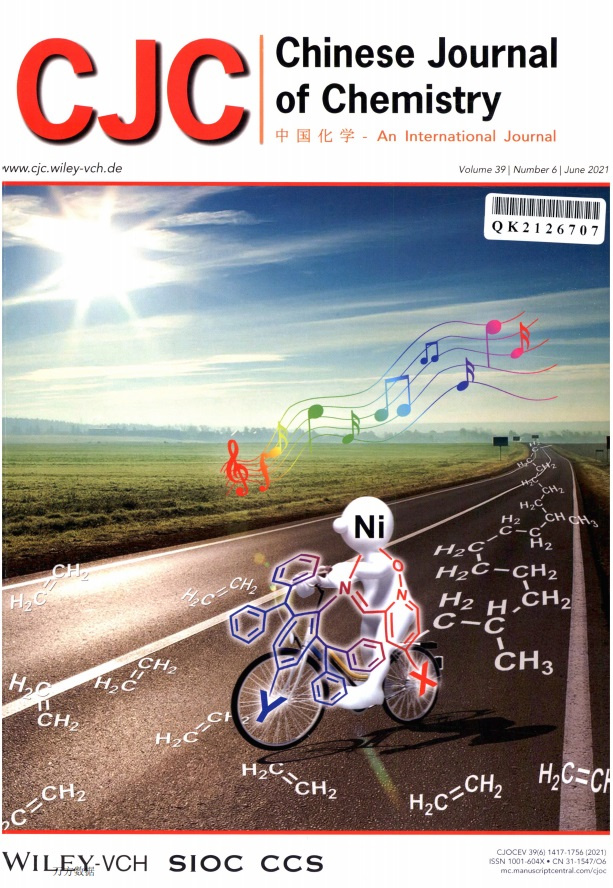
Chinese Journal of Chemical Engineering投稿地址
Chinese Journal of Chemical Engineering詳細信息
Chinese Journal of Chemical Engineering
Chinese Journal of Chemical Engineering
Chinese Journal of Chemical Engineering投稿要求
Chinese Journal of Chemical Engineering雜志投稿須知:Title. Concise and informative. Titles are often used in information-retrieval systems. Avoid abbreviations and formulae where possible.? Author names and affiliations. Please clearly indicate the given name(s) and family name(s) of each author and check that all names are accurately spelled. Present the authors' affiliation addresses (where the actual work was done) below the names. Indicate all affiliations with a lower-case superscript letter immediately after the author's name and in front of the appropriate address. Provide the full postal address of each affiliation, including the country name and, if available, the e-mail address of each author.? Corresponding author. Clearly indicate who will handle correspondence at all stages of refereeing and publication, also post-publication. Ensure that the e-mail address is given and that contact details are kept up to date by the corresponding author.? Present/permanent address. If an author has moved since the work described in the article was done, or was visiting at the time, a 'Present address' (or 'Permanent address') may be indicated as a footnote to that author's name. The address at which the author actually did the work must be retained as the main, affiliation address. Superscript Arabic numerals are used for such footnotes.Abstract A concise and factual abstract is required. The abstract should state briefly the purpose of the research, the principal results and major conclusions. An abstract is often presented separately from the article, so it must be able to stand alone. For this reason, References should be avoided, but if essential, then cite the author(s) and year(s). Also, non-standard or uncommon abbreviations should be avoided, but if essential they must be defined at their first mention in the abstract itself.Graphical Abstract A Graphical abstract is optional and should summarize the contents of the article in a concise, pictorial form designed to capture the attention of a wide readership online. Authors must provide images that clearly represent the work described in the article. Graphical abstracts should be submitted as a separate file in the online submission system. Image size: Please provide an image with a minimum of 531 × 1328 pixels (h × w) or proportionally more. The image should be readable at a size of 5 ×13 cm using a regular screen resolution of 96 dpi. Preferred file types: TIFF, EPS, PDF or MS Office files. Highlights Highlights are mandatory for this journal. They consist of a short collection of bullet points that convey the core findings of the article and should be submitted in a separate file in the online submission system. Please use 'Highlights' in the file name and include 3 to 5 bullet points (maximum 85 characters, including spaces, per bullet point). Keywords Authors are invited to submit a maximum of 6 keywords associated with their paper, using British or American spelling and avoiding general and plural terms and multiple concepts (avoid, for example, "and", "of"). Be sparing with abbreviations: only abbreviations firmly established in the field may be eligible. These keywords will be used for indexing purposes. At least 3 of these keywords should be chosen from the list of recommended keywords.Abbreviations Define abbreviations that are not standard in this field in a footnote to be placed on the first page of the article. Such abbreviations that are unavoidable in the abstract must be defined at their first mention there, as well as in the footnote. Ensure consistency of abbreviations throughout the article.Acknowledgements Collate acknowledgements in a separate section at the end of the article before the references and do not, therefore, include them on the title page, as a footnote to the title or otherwise. List here those individuals who provided help during the research (e.g., providing language help, writing assistance or proof reading the article, etc.).Formatting of funding sources List funding sources in this standard way to facilitate compliance to funder's requirements:Funding: This work was supported by the National Institutes of Health [grant numbers xxxx, yyyy]; the Bill & Melinda Gates Foundation, Seattle, WA [grant number zzzz]; and the United States Institutes of Peace [grant number aaaa].It is not necessary to include detailed descriptions on the program or type of grants and awards. When funding is from a block grant or other resources available to a university, college, or other research institution, submit the name of the institute or organization that provided the funding.If no funding has been provided for the research, please include the following sentence:This research did not receive any specific grant from funding agencies in the public, commercial, or not-for-profit sectors.Nomenclature and units Follow internationally accepted rules and conventions: use the international system of units (SI). If other quantities are mentioned, give their equivalent in SI. Prohibit the use of the following non-SI units, e.g. M, ppm, bar, atm, ?, cal, et al. Authors wishing to present a table of nomenclature should do so on the second page of their manuscript.Math formulae Please submit math equations as editable text and not as images. Present simple formulae in line with normal text where possible and use the solidus (/) instead of a horizontal line for small fractional terms, e.g., X/Y. In principle, variables are to be presented in italics. Powers of e are often more conveniently denoted by exp. Number consecutively any equations that have to be displayed separately from the text (if referred to explicitly in the text).Footnotes Footnotes should be used sparingly. Number them consecutively throughout the article. Many word processors can build footnotes into the text, and this feature may be used. Otherwise, please indicate the position of footnotes in the text and list the footnotes themselves separately at the end of the article. Reference Style References should be numbered in the order of appearance. The following are examples of different types of references.
1、 S.M. Kresta, Characterization, measurement and prediction of the turbulent flow in stirred tanks, Ph. D. Thesis,McMaster Univ., Canada?1991.。
2、 Q.Yu, J.T. Matheickal, P. Yin, P. Kaewsarn, Heavy metal uptake capacities of biomass: A comparison,Proceedings of Chemeca'98, Port Douglas, Australia, 1998.。
3、 J.X. Xu, A survey on iterative learning control for nonlinear systems, Int. J. Control, 84 (7) (2001)1275-1294.。
4、 T. Brawn, Extraction Chromatography, Elsevier, Amsterdam?1975.。
5、 S. Osaki, Multistage vortex pump, Japan Pat., 62186095 (1986).
Chinese Journal of Chemical Engineering雜志簡介
The Chinese Journal of Chemical Engineering (Bimonthly, started in 1982) is the official journal of the Chemical Industry and Engineering Society of China and published by the Chemical Industry Press. The aim of the journal is to develop the international exchange of scientific and technical information in the field of chemical engineering. It publishes original research papers that cover the major advancements and achievements in chemical engineering in China as well as some articles from overseas contributors. The topics of journal include chemical engineering, chemical technology, biochemical engineering, energy and environmental engineering and other relevant fields. Papers are published on the basis of their relevance to theoretical research, practical application or potential uses in the industry as Research Papers, Research Notes, Chemical Engineering Data and Reviews. Prominent domestic and overseas chemical experts and scholars have been invited to form an International Advisory Board and the Editorial Committee. It enjoys recognition among Chinese academia and industry as a reliable source of information of what is going on in chemical engineering research, both domestic and abroad.
Chinese Journal of Chemical Engineering統計分析
影響因子:指該期刊近兩年文獻的平均被引用率,即該期刊前兩年論文在評價當年每篇論文被引用的平均次數
被引半衰期:衡量期刊老化速度快慢的一種指標,指某一期刊論文在某年被引用的全部次數中,較新的一半被引論文刊載的時間跨度
他引率:期刊被他刊引用的次數占該刊總被引次數的比例用以測度某期刊學術交流的廣度、專業面的寬窄以及學科的交叉程度
引用半衰期:指某種期刊在某年中所引用的全部參考文獻中較新的一半是在最近多少年時段內刊載的
平均引文數:在給定的時間內,期刊篇均參考文獻量,用以測度期刊的平均引文水平,考察期刊吸收信息的能力以及科學交流程度的高低
熱門評論
編輯部的老師和審稿專家,編輯部老師對文章的初審速度出奇的快,11-12早上10點投稿,中午14點通過初審,此時便開始外審生涯,30天審稿結束,專家給出的意見是:修改后以研究論文的形式發表,責編意見是:修改后可以發表!
我中了一篇關于臨床研究的文章。我覺得編輯的態度還不錯,電話通知讓修改,并詳細說明了如何修改,7月04日提交修改稿,8月24日變為終審中,10月20日變為已錄用。編輯部效率很快,贊!審改老師對文章分析也相當透徹,整理出了文章的亮點和不足。非常細致!
審稿速度還是很快的,在我投的幾篇中是最快的,編輯很好,打電話咨詢的時候,態度非常好,還打電話告訴修改的內容。
該雜志的投稿系統做得非常不錯,初審,主編審定等都會安排具體時間,一般都會提前完成,超過了規劃時間作者可以電話詢問,編輯部也會給出合理的解釋,我的稿件一個月以內就通過初審,退修后很快給出意見錄用。
該刊的編輯態度很好,和善并且負責,面對疑問都耐心給我解答!并且編輯部工作人員處理速度也非常快、工作規范,對問題的處理既細心又耐心。非常不錯!是一個值得推薦的雜志
Chinese Journal of Chemical Engineering雜志審稿速度還是很快的,編輯也很耐心負責。專家修回意見,比較中肯,有參考價值。按照以往說法,如果是修改后編輯終審,一般問題都不大。所以認真按照專家意見條條回復修改后,即時上傳修改稿。很快就收到了收錄的好消息
在投稿網買了好多書,豐富自己精神世界,每一本都是好書,養成閱讀的習慣。《Chinese Journal of Chemical Engineering》集專業性、指導性、服務性、可讀性于一體,非常有學術價值。收錄了很多優秀的文章。
Chinese Journal of Chemical Engineering總體審稿速度較快,編輯修改太細致了,第一次給該刊投稿,中了!高興!沒過好久就通知錄用,修改1次后錄用,速度還算快。很感謝編輯。
Chinese Journal of Chemical Engineering審稿人還是比較認真的,給修改的也比較仔細,對創新性要求還算比較高吧,但是說結果是可以預見的有點勉強。推薦除非有比較好的創新性投稿!
Chinese Journal of Chemical Engineering真的是一個非常不錯的雜志,審稿流程很是規范、謹慎。編輯態度很好,校稿過程中都會主動打電話過來討論文章的錯誤點,非常敬業。
相關問題
- Chinese Journal of Chemical Engineering是正規期刊嗎?
- Chinese Journal of Chemical Engineering是什么級別的期刊?是核心期刊嗎?
- Chinese Journal of Chemical Engineering評職稱可以嗎?單位認可嗎?
- Chinese Journal of Chemical Engineering是北大核心嗎?是中文核心嗎?
- Chinese Journal of Chemical Engineering是科技核心嗎?
- Chinese Journal of Chemical Engineering是統計源核心嗎?
- Chinese Journal of Chemical Engineering是南大核心CSSCI嗎?
- Chinese Journal of Chemical Engineering是CSCD期刊嗎?
- Chinese Journal of Chemical Engineering是國家級期刊嗎?
- Chinese Journal of Chemical Engineering是SCD期刊嗎?
- Chinese Journal of Chemical Engineering是國家新聞出版署第一批、第二批學術期刊嗎?
- Chinese Journal of Chemical Engineering好投嗎?Chinese Journal of Chemical Engineering簡介
相關期刊
更多常見問題
| Q:論文發表的時候可以一稿多投嗎? |
| A:一稿多投的行為是典型的學術不端的行為,是國內外學術界都明令禁止的行為,原因主要在于涉及到文章版權歸屬的問題,如果作者的文章已經被某個雜志社錄用,或者同時被兩家雜志社錄用,就會涉及到版權糾紛,作為雜志社都會保護本社的合法權益,到這時作者就會比較麻煩,吃官司都是小事兒了,被打入黑名單降級降職影響可就太大了。 |
| Q:職稱論文發表對時間有限制嗎? |
| A:職稱論文發表并沒有明確規定截止時間,需要作者結合自己所在地區的具體規定自己安排發表時間,一般職稱評審,各地區都會明確規定申報材料的最后期限和截止日期,我們結合這個日期來考慮何時發表文章就可以,大部分地區職稱評審都集中在每年的8-10月之間,有的地區要求7月中旬開始交材料,最晚8月底之前,有的則是要求8月中旬交,還有部分地區要求截止時間為申報時間上年的12月31日,所以,各個地區的具體要求并不同,申報者需要在提交材料前確保自己的文章已經見刊并且被相應的數據庫檢索即可。 |
| Q:網上發表論文如何防騙?可靠網站與可疑網站如何區分? |
| A:由于發表論文的需求遠遠多于雜志版面的供應,再加上眾所周知的審稿難!審稿慢!選擇論文發表網站發表表論文確實能解決以上問題。賣方市場的出現加之發表論文的剛性需求,就導致出現先付款后發表的現狀。論文發表網站正規與否是通過網站從始至終所提供服務體現出來的,任何交易只要存在時間差都會有風險,但這個風險是可以通過您的智慧來避免的。因為不是所有論文網站都是騙子,你要做的就是過濾掉沒保障的網站,選擇可靠的論文發表網站! |
| Q:一般期刊需要提前多久準備? |
| A:省級、國家級期刊建議至少提前6個月準備。一般來講,雜志社為了確保每期雜志正常出刊,都會提前將當期之后1-3個月的稿件提前安排好,而一些創刊較早,認可度更高的熱門期刊,來稿量較大,發表周期可能就會更久。提前準備,意味著雜志的可選擇性更多。 |
| Q:核心期刊需要提前多久準備? |
| A:核心期刊建議至少提前12個月準備,核心期刊正常的審稿周期為1-3個月,且審核嚴格,退稿、返修幾率更大,這意味著在流程上耗費的時間更久,且核心期刊版面有限,投稿競爭更加激烈,即使被錄用,排刊也比普通期刊晚很多,因此需要更早準備。 |






